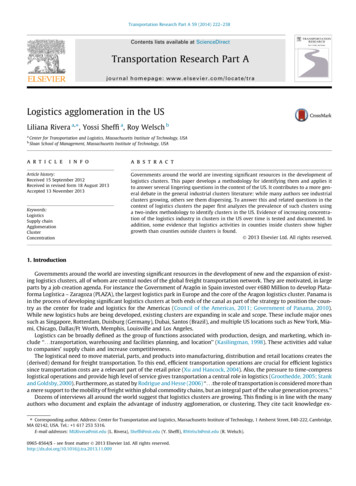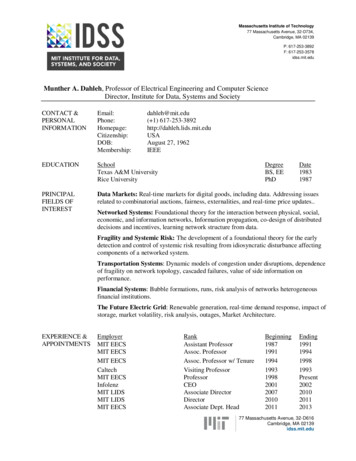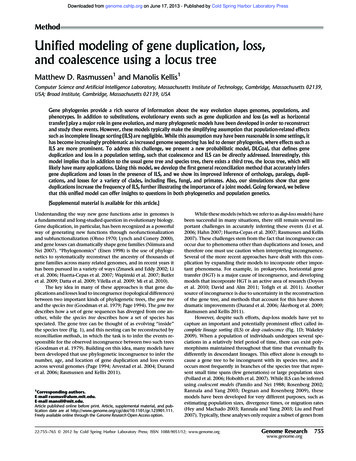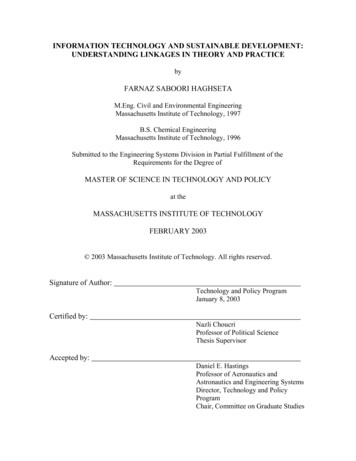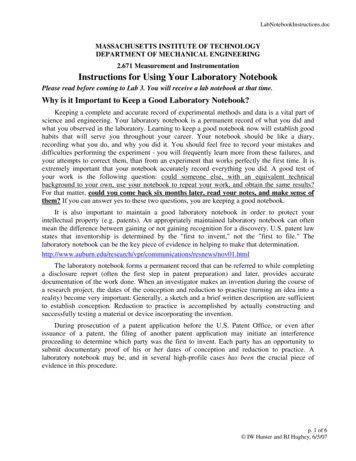
Transcription
LabNotebookInstructions.docMASSACHUSETTS INSTITUTE OF TECHNOLOGYDEPARTMENT OF MECHANICAL ENGINEERING2.671 Measurement and InstrumentationInstructions for Using Your Laboratory NotebookPlease read before coming to Lab 3. You will receive a lab notebook at that time.Why is it Important to Keep a Good Laboratory Notebook?Keeping a complete and accurate record of experimental methods and data is a vital part ofscience and engineering. Your laboratory notebook is a permanent record of what you did andwhat you observed in the laboratory. Learning to keep a good notebook now will establish goodhabits that will serve you throughout your career. Your notebook should be like a diary,recording what you do, and why you did it. You should feel free to record your mistakes anddifficulties performing the experiment - you will frequently learn more from these failures, andyour attempts to correct them, than from an experiment that works perfectly the first time. It isextremely important that your notebook accurately record everything you did. A good test ofyour work is the following question: could someone else, with an equivalent technicalbackground to your own, use your notebook to repeat your work, and obtain the same results?For that matter, could you come back six months later, read your notes, and make sense ofthem? If you can answer yes to these two questions, you are keeping a good notebook.It is also important to maintain a good laboratory notebook in order to protect yourintellectual property (e.g. patents). An appropriately maintained laboratory notebook can oftenmean the difference between gaining or not gaining recognition for a discovery. U.S. patent lawstates that inventorship is determined by the "first to invent," not the "first to file." Thelaboratory notebook can be the key piece of evidence in helping to make that ommunications/resnews/nov01.htmlThe laboratory notebook forms a permanent record that can be referred to while completinga disclosure report (often the first step in patent preparation) and later, provides accuratedocumentation of the work done. When an investigator makes an invention during the course ofa research project, the dates of the conception and reduction to practice (turning an idea into areality) become very important. Generally, a sketch and a brief written description are sufficientto establish conception. Reduction to practice is accomplished by actually constructing andsuccessfully testing a material or device incorporating the invention.During prosecution of a patent application before the U.S. Patent Office, or even afterissuance of a patent, the filing of another patent application may initiate an interferenceproceeding to determine which party was the first to invent. Each party has an opportunity tosubmit documentary proof of his or her dates of conception and reduction to practice. Alaboratory notebook may be, and in several high-profile cases has been the crucial piece ofevidence in this procedure.p. 1 of 6 IW Hunter and BJ Hughey, 6/5/07
LabNotebookInstructions.docRules for Maintaining your Laboratory NotebookLeave several pages blank at the beginningfor a Table of Contents and update it whenyou start each new experiment or topicAlways use pen and write neatly and clearlyDate every page on the top outside cornerStart each new topic (experiment, notes,calculation, etc.) on a right-side (oddnumbered) pageDATETITLEObjectives and/orpurpose ofexperimentR 3.256 Ω3.526R 3.256 Ω3.526 miswroteRecord the TITLE and OBJECTIVES of eachexperiment (or notes or calculations) at thetop of the first page of the notebookdedicated to this topic.If you make a mistake, don’t obliterate it!You may need to read your mistake later –perhaps you were right the first time!Use a single cross out and EXPLAIN why itwas an error.Data typed into the computer must beprinted and taped into your lab notebook.Plots of data made in lab should also beprinted and taped in your lab notebook.When I did .orStep 2.4.1 I measured thefollowing .When you record an observation in yournotebook, include an explanation of what youwere doing at the time. If appropriate, youmay just record the step number in theinstructions followed by your observation.p. 2 of 6 IW Hunter and BJ Hughey, 6/5/07
LabNotebookInstructions.docYou must have your lab notebook signed byDr. Hughey or your lab professor before youleave lab each day. Any pages not signed onthe day the experiment was performed willadversely affect your lab notebook gradeMetricRequirementsPenWrite in pen, not pencil10%DateDate every page at the top10%Right SideBegin each experiment on odd page10%PrintoutsAttach printouts and plots of data as needed10%LegibleObvious care taken to make it readable,even if you have bad handwriting10%MistakesMistakes crossed out with one line and explained10% table of contents title of experiment on 1st page objectives of experiment clear from notebook what you were doing when20% all required data and information descriptive comments of your observations20%OrganizedInformativeWorthp. 3 of 6 IW Hunter and BJ Hughey, 6/5/07
LabNotebookInstructions.docExample: Complete ExperimentDo not copy the words from this example into your notebook – some of the experimentalprocedure has changed!First Page:Date at topouter cornerExperiment startson an odd pageExperiment numberand title clearly statedClear statement ofpurposeSpec sheet tapedinto lab notebookSuccinct description ofprocedure.The step number fromthe instructions couldalso be listedNotebook signed on sameday as experiment performedp. 4 of 6 IW Hunter and BJ Hughey, 6/5/07
Second page for Example 1Date at topouter cornerLabNotebookInstructions.docDescription of somethingthat went wrong in theexperiment and what wasdone to correct the problemIdentification of whichmember of the team didwhich task.Schematic drawingmakes clear to what themeasured resistancesR1 and R2 refer.Model number ofthe power supplyspecifiedComputation:1. Intermediate steps shown2. Errors crossed out with a single line and an explanation (“calculator error”).p. 5 of 6 IW Hunter and BJ Hughey, 6/5/07
LabNotebookInstructions.docRemaining pages for Example 1:Error crossed offwith explanationAnswer to the questionposed by the experimentKey points in this example:1. Neat and legible handwriting2. Experiment title and purpose clearly stated3. Procedure described clearly and succinctly, including errors and the steps taken to correctthem4. Computations performed neatly showing intermediate steps5. Errors crossed out with a single line and explained6. All pages dated at the top and signed by lab professor on the same datep. 6 of 6 IW Hunter and BJ Hughey, 6/5/07
Please read before coming to Lab 3. You will receive a lab notebook at that time. Why is it Important to Keep a Good Laboratory Notebook? Keeping a complete and accurate record of experimental methods and data is a vital part of science and engineering. Your laboratory notebook is a permanent record of what you did and what you observed in the .
